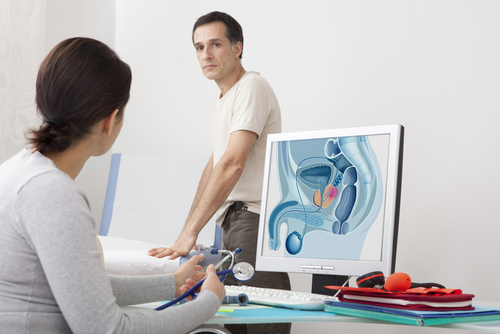Men with less aggressive prostate cancer who opt for active surveillance instead of surgery or radiotherapy have a good quality of life, similar to that of men without cancer, according to long-term research presented at the 2016 European Association of Urology Congress in Munich, titled “Long-term quality of life outcomes after active surveillance or curative treatment for prostate cancer.”
Prostate cancer affects some 400,000 men every year in Europe, and most patients are treated either with radiotherapy (RT) or radical prostatectomy (RP). These treatments, while necessary in many cases, are associated with side effects that can include erectile dysfunction or incontinence. An alternative for patients with less aggressive prostate cancers is to avoid or delay initial treatment, undergoing what’s known as Active Surveillance (AS). The cancer in these people is monitored regularly, and they have the option of switching to curative treatment should the tumor change.
Researchers evaluated whether AS helps patients with prostate cancer enjoy, over the long term, a better quality of life. A total of 427 patients with low-risk prostate cancer, ages 66 to 69, were assessed for life quality and then followed for five to 10 years after diagnosis. Of these, 121 patients opted for AS, 74 had surgery, and 232 were treated with radiotherapy. A control group of 204 men without prostate cancer, matched for age, was also examined.
Patients choosing AS reported higher quality of life scores compared to those who had undergone surgery (RP), and better urinary function, sexual function, and fewer reports of urinary incontinence. Results of a comparison of AS with radiotherapy, likewise, found a significantly higher sexual satisfaction score in the AS group. Overall, the quality of life in AS patients was identical to that of men without prostate cancer, although this result was not statistically significant.
Dr. Lionne Venderbos, of the department of Urology at Erasmus University Medical Center in Rotterdam, who led the research, said in a press release: “When choosing treatment, it is important that men think about the potential side-effects that are related to immediate curative treatment, like becoming incontinent or losing the ability to have an erection. When considering active surveillance they should try to imagine whether living with untreated cancer would cause any stress, or that the follow-up visits lead to stress instead of reassurance. Balancing the advantages and disadvantages per type of treatment, will make that a man chooses that type of treatment that fits his wishes and preferences best.”
Dr Alberto Briganti, section editor of European Urology Focus and a member of EAU Scientific Congress Committee, added: “This is an interesting study which corroborates the notion that active surveillance is not only safe but well accepted by patients as possible initial management of low risk prostate cancer. While we could have … anticipated overall lower sexual and urinary function in men treated with surgery or radiation therapy as compared to men receiving AS, it is interesting to note that long-term quality of life of men on AS was comparable to that of men without prostate cancer. Proper patient counseling about [the] safety of AS is key to maintain both good quality of life, and intact psychological and functional well-being over time. We also need to note that it is possible that patients choosing AS may be less disposed to accept any form of treatment, and this might be difficult to uncover via the retrospective comparisons of validated questionnaires.”

